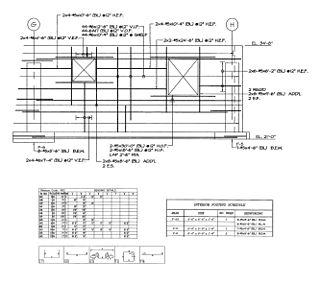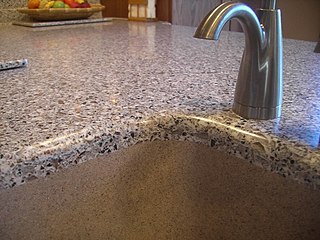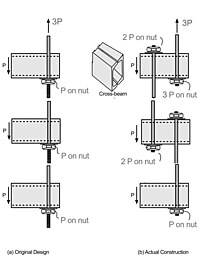
An architect is a person who plans, designs and oversees the construction of buildings. To practice architecture means to provide services in connection with the design of buildings and the space within the site surrounding the buildings that have human occupancy or use as their principal purpose. Etymologically, the term architect derives from the Latin architectus, which derives from the Greek, i.e., chief builder.

A prototype is an early sample, model, or release of a product built to test a concept or process. It is a term used in a variety of contexts, including semantics, design, electronics, and software programming. A prototype is generally used to evaluate a new design to enhance precision by system analysts and users. Prototyping serves to provide specifications for a real, working system rather than a theoretical one. In some design workflow models, creating a prototype is the step between the formalization and the evaluation of an idea.

Metal fabrication is the creation of metal structures by cutting, bending and assembling processes. It is a value-added process involving the creation of machines, parts, and structures from various raw materials.
Design–bid–build, also known as Design–tender, traditional method, or hardbid, is a project delivery method in which the agency or owner contracts with separate entities for the design and construction of a project.
The Construction Specifications Institute (CSI) is a United States national association of more than 8,000 construction industry professionals who are experts in building construction and the materials used therein. The institute is dedicated to improving the communication of construction information through a diversified membership base of allied professionals involved in the creation and management of the built environment, continuous development and transformation of standards and formats, education and certification of professionals to improve project delivery processes, and creation of practice tools to assist users throughout the facility life-cycle. The work of CSI is currently focused in three areas being standards and publications, construction industry professional certifications, and continuing education for construction professionals.
A general contractor, main contractor, prime contractor, builder (UK/AUS), or contractor is responsible for the day-to-day oversight of a construction site, management of vendors and trades, and the communication of information to all involved parties throughout the course of a building project. In the USA a builder may be a sole proprietor managing a project and performing labor or carpentry work, have a small staff, or may be a very large company managing billion dollar projects. Some builders build new homes, some are remodelers, some are developers.
Construction management (CM) is a professional service that uses specialized, project management techniques and software to oversee the planning, design, construction and closeout of a project. The purpose of construction management is to control the quality of a project's scope, time / delivery and cost—sometimes referred to as a project management triangle or "triple constraints." CM is compatible with all project delivery systems, including design-bid-build, design-build, CM At-Risk and Public Private Partnerships. Professional construction managers may be hired for large to jumbo-scale, high budget undertakings, called capital projects.
A steel detailer is a person who produces detailed drawings for steel fabricators and steel erectors. The detailer prepares detailed plans, drawings and other documents for the manufacture and erection of steel members used in the construction of buildings, bridges, industrial plans, and nonbuilding structures.
The cleanroom software engineering process is a software development process intended to produce software with a certifiable level of reliability. The central principles are software development based on formal methods, incremental implementation under statistical quality control, and statistically sound testing.

Precast concrete is a construction product produced by casting concrete in a reusable mold or "form" which is then cured in a controlled environment, transported to the construction site and maneuvered into place; examples include precast beams, and wall panels for tilt up construction. In contrast, cast-in-place concrete is poured into site-specific forms and cured on site.

In manufacturing and design, a mockup, or mock-up, is a scale or full-size model of a design or device, used for teaching, demonstration, design evaluation, promotion, and other purposes. A mockup may be a prototype if it provides at least part of the functionality of a system and enables testing of a design.
Production Part Approval Process (PPAP) is used in the Aerospace or automotive supply chain for establishing confidence in suppliers and their production processes. Actual measurements are taken from the parts produced and are used to complete the various test sheets of PPAP.
"All customer engineering design record and specification requirements are properly understood by the supplier and that the process has the potential to produce product consistently meeting these requirements during an actual production run at the quoted production rate." Version 4, 1 March 2006

A shop drawing is a drawing or set of drawings produced by the contractor, supplier, manufacturer, subcontractor, consultants, or fabricator. Shop drawings are typically required for prefabricated components. Examples of these include: elevators, structural steel, trusses, pre-cast concrete, windows, appliances, cabinets, air handling units, and millwork. Also critical are the installation and coordination shop drawings of the MEP trades such as sheet metal ductwork, piping, plumbing, fire protection, and electrical. Shop drawings are produced by contractors and suppliers under their contract with the owner. The shop drawing is the manufacturer’s or the contractor’s drawn version of information shown in the construction documents. The shop drawing normally shows more detail than the construction documents. It is drawn to explain the fabrication and/or installation of the items to the manufacturer’s production crew or contractor's installation crews. The style of the shop drawing is usually very different from that of the architect’s drawing. The shop drawing’s primary emphasis is on the particular product or installation and excludes notation concerning other products and installations, unless integration with the subject product is necessary.
A specification often refers to a set of documented requirements to be satisfied by a material, design, product, or service. A specification is often a type of technical standard.
Construction bidding is the process of submitting a proposal (tender) to undertake, or manage the undertaking of a construction project. The process starts with a cost estimate from blueprints and material take offs.

The Construction Project Information Committee is an advisory group, comprising representatives of major UK construction industry institutions, which provides best practice guidance on the content, form and preparation of construction production information, and disseminates this throughout the industry.
Building commissioning (Cx) is an integrated, systematic process to ensure, through documented verification, that all building systems perform interactively according to the "Design Intent". The commissioning process establishes and documents the "Owner's Project Requirements (OPR)" criteria for system function, performance expectations, maintainability; verify and document compliance with these criteria throughout all phases of the project. Commissioning procedures require a collaborative team effort and 'should' begin during the pre-design or planning phase of the project, continue through the design and construction phases, initial occupancy phase, training of operations and maintenance (O&M) staff, and into occupancy.

Solid surface is a man-made material usually composed of a combination of alumina trihydrate (ATH), acrylic, epoxy or polyester resins and pigments. It is most frequently used for seamless countertop installations.
Rebar detailing is the discipline of preparing 'shop/placing' or 'fabrication' drawings or shop drawings of steel reinforcement for construction.
The following is a glossary of terms relating to construction cost estimating.









